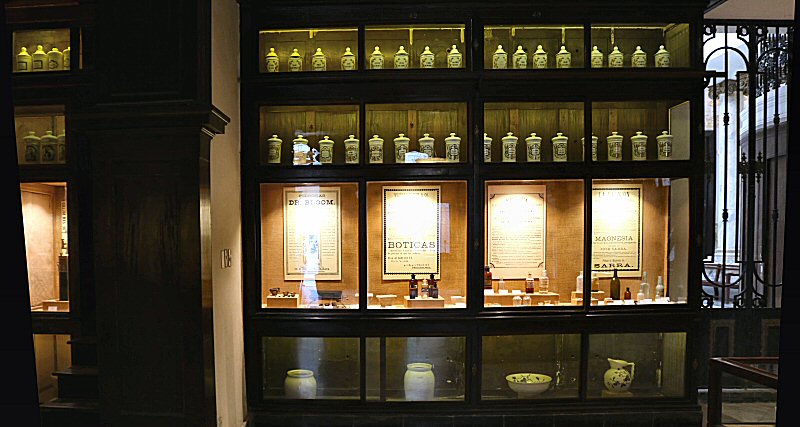
The three-storey building
has an art deco façade. The pharmacy can be accessed by both
the Compestela and the Brasil streets. The name
Sarrá was engraved on the floor of one of the entrances.
The interior is designed
by the French fashion that dominated Havana in the last
quarter of the 19th century. All of the walls of the
interior are covered by hundreds of porcellain apothecary
jars resting on carved shelves made of precious wood. These
are the reproductions of the original jars that would once
have contained the medicinal mixtures of all kind sold here.
The excellent carpentry work with neo Gothic style has also
somewhat Moorish influence. During the restoration great
care was taken in the reproduction of the deteriorated wood
or in the replacement of the pieces of the carpentry that
did not exist anymore. The porcellain jars bear the emblem
of La Réunion. The luminaires at the extravagantly adorned
ceiling illuminate the rooms and the marble floor with their
soft tone bulbs. They were commissioned to Italy to produce
the copy of the originals during the restoration.
The room at the corner of
the building was the place where the apotheracy was staying.
It is decorated with mirrors ornamented with colored flower
figures that are in excellent harmony with the red colored
transparent jars. The instruments used by the apothecary
like the scales, weights and a microscope, are exhibited in
the showcases. In this area the visitor can see the
medicines and the natural products of the old pharmacy that
are still sold, such as Scout Emulsion and Spirulina.
Scout Emulsion contains cod liver oil with vitamin A and D,
and used in children to increase their resistance to
infections like coughs and colds and to develop stronger
bones and teeth. Spirulina is a tiny, multicellular
photosynthetic alga, bluish-green in color. It is extremely
high in many nutrients like protein, copper, iron and
vitamin B, has powerful antioxidant and antiinflammatory
properties, and can lower the cholesterol level. The Aztec
messengers that needed great energy and resistance that
would allow them to run for days, were consuming spirulina
cakes. Likewise, Javier Sotomayor Sanabria, the Cuban
athlete specialized in high jump and the current world
record holder with his jump of 2.45 meters, and Lee Evans,
the Olympic champion runner, owner of the two gold medals
and holder of four world records, recognized the consumption
of spirulina as a nutritional supplement.
The central room of the
pharmacy stands out with the excellent stained glass
decoration that creates a nice ambience in the dim light of
the room. They are the work of the artist Rosa
María de la Terga, and exhibit an interesting mixture
of neo-Gothic and modernism. The glass doors of the main
bookcase at the back of this place are imitated in an almost
exact way using the old photos during the restoration.
This room
is dedicated to panels with texts on
which the benefits of some drugs, produced in the laboratory
of the pharmacy, are explained in the style of a publicity
poster. The bottles in which these medicines and natural
products are sold, as well as the containers, flasks,
mortars and the instruments like pildoreros (used in the
production of pills), scales and microscope, that were used
in their production process are exhibited in front of the
panels. There are also water filters and an old autoclave to
sterilize the instruments of the production process of the
pharmaceuticals. Most of these bottles and tools, related to
the art of curing like surgical and dental instruments, were
extracted from archaeological excavations, carried out in
the historic center of Havana. There are also posters on
which the surgical instruments of a French company, used in
opthalmology, otorhinolaryngolgy and general surgery are
presented. The panels that reflect the advertisements of the
time, show us some hints about the running of the business
at that time, providing us the opportunity to make an
analysis of the social life in Havana in the colonial time.
On the desk, there are
some books in that the formulas of several medicines and
natural products were recorded. They are of great value to
understand the development of the pharmaceutics in Cuba. The
visitor can receive information about the history of
pharmacy in Cuba by reading the chronology on the text on
the column in the center of the museum..
The last room, where
formerly spices and medicinal plants were also sold, is
dedicated to the sale of only natural and traditional
pharmaceuticals today. The visitor can observe the process
of preparing the drugs according to the formula in the
laboratory.
On the tour of the museum
the visitor can alternatively see the products for sale and
the pieces of high collection value and some archeological
items. It should be not forgotten that such pharmacies in
the island played an important role, when Cuba had
difficulties in the supply of active ingredients of
traditional medicine due to the economic, financial and
commercial embargo imposed by the United States.
